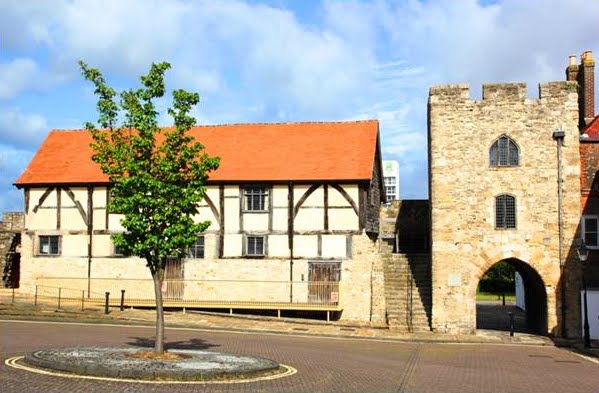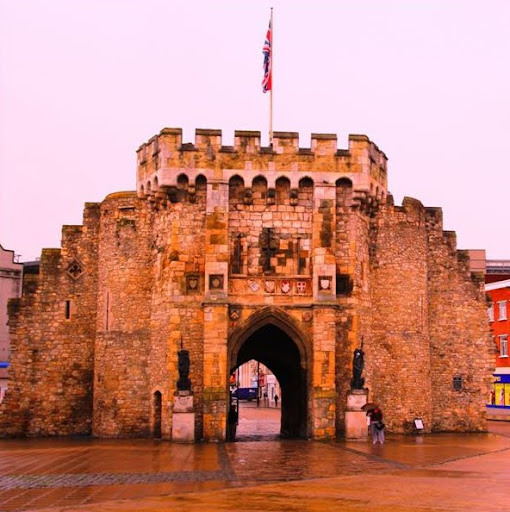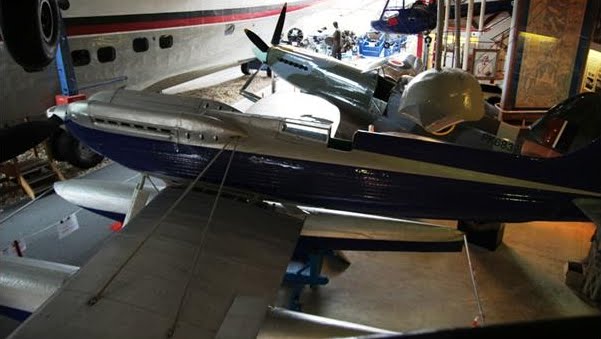A Most Im-PORT-Ant City
A MOST IM-PORT-ANT CITY
Oh, I delight in English weather
Just in case there’s any doubt,
If not for all the wind and rain
There’s naught else, to talk about.
I am sure that in the pantheon of port cities, Southampton is somewhere near the top. Wedged originally between the Rivers Test and Itchen, with its broad-water shaped like a clarinet to the Solent, it has stood as a fortress town since Roman times, when it served as a port for the Wessex capital, Winchester. Fortified and walled by the Saxons, Normans and later the Plantagenet kings, sacked by the French, Monegasques, and bombed by the Germans, it was from where Henry ‘high-Five’ left for Agincourt in 1415, the Pilgrim Fathers in the Mayflower in 1620, the RMS Titanic in 1912, and the Allied forces to embark for D-Day in June, 1944. Renowned as a centre for shipbuilding, sea-bathing, and the berthing of numerous ‘Queens,’ it is also the birthplace of the Spitfire and a number of flying boats. Today, it is a city of nearly 250,000 Sotonians, which I am assured, has nothing to do with the derivative ‘Sot,’ as in ‘drunken sot,’ although it may well have been applicable earlier this year, when Southampton F.C. returned to the English Premier League after a long absence.
We were very lucky to be staying with family in Southampton, in a very smart townhouse in the rather smart Ocean Village, once an outer harbor area with stone wharves and great rail gantries. No doubt there was significant bomb damage to the area during WWII, and it has been turned into a flashy marina with lots of trendy apartments, bars and eateries, and is the start, and finish, for the Volvo Round the World yacht race. That first morning, I was out walking, in the drizzle, and stopped at a plaque which said that on 5 June 1944, the harbor was emptied of landing craft full of allied soldiers, who came ashore at Normandy, the following day.
I followed Canute Road (Yes, named after the Danish King of England, he of “roll back the waves” fame) where the buildings were older, with that elaborate grandeur of when stone masons were a penny a dozen and there was time and expertise to create griffins, gargoyles and heraldic coats of arms. A small plaque on a brick gate-post outside a modest chambers, advised that this had been the shipping offices of the White Star Line, the owners of the RMS Titanic, and that “It was here that hundreds of local people waited for news of their loved ones.” Four out of every five crew members on the Titanic were Sotonians and one-third of those who died, 549 out of 1514, were local citizens.

Canute Chambers, once the offices of the White Star Line
Southampton retains its intimate connection with the Titanic. The railway station, where passengers from London alighted, is now a casino, the swank South Western Hotel near the Titanic Dock where the First Class passengers had their last night ashore still stands, the hotels and bars on Oxford Street where the crew and other ‘classes’ had their last orders, are little changed. Why even the railway level crossing which was closed at the time and caused some staff to miss the sailing, still operates.
The Sea City museum in the city centre, has a superb Titanic exhibit giving insight into the lives of people at the time, Captain Smith, Second Officer Lightoller, cabin boys and stokers. There are displays of items from the Titanic including a fob watch from the body of a cabin steward, the time frozen forever when he entered the water. In a simulation, you can take the wheel of the Titanic, and the telegraph, and guide the great ship down Southampton Water and round the great bend where the Calshot light-ship warned of a dangerous bar, a task much harder than it looked. There is a mock-up of the Marconi Room where you can try to emulate Jack Phillips sending his Morse messages, without any fears of the rising waters which took him. You can sit in the somber courtroom and listen to actors speaking the lines from the transcript of the official enquiry into the sinking. It is all most evocative. Then around Southampton too, there are further plaques and memorials – to the ship’s engineers who died, and another to the valiant musicians who played while the ship went down.
Canute Road too carries the buildings of long gone grand shipping companies. The Union Castle Line building still stands replete, while the names of others have faded and are now used by businesses and invariably, law firms. In Queen’s Park, there was a memorial to the pluck of General Gordon of Khartoum and further along, a memorial to the passengers on the Mayflower. Indeed, all around Southampton there are memorials and statues to the former PM, Lord Palmerston, various aldermen, war memorials to soldiers in the Crimea, the Boer War, and the First and Second World Wars. They stand in lovely shady parks amid the oaks and elms, colourful flower beds of roses and poppies, with fountains that prattle, all surrounded by a sea of lush green grass, bisected by paths in great geometric design showing planners familiarity with Isosceles.

Forever England, phone box red, oak green, cricket field, in the rain!
There was too, almost in the middle of town, a village cricket green, with white sight-screens and in sight of old buildings and church spires. It made me realize that I had never ‘really’ played cricket, for while I have fronted the game all over the world, I have never played cricket in England. Before the rain, men sat in deck chairs, straw hats on their heads, passers-by stopped to watch a few balls and women with kiddies in strollers, and a phalanx of noisy brethren, ambled by. Ahhh, but then dark clouds hovered while the sun shone fleetingly, umbrellas were furled, but near, and the ground covers stacked for instant deployment. That too, is cricket in England.
The ‘igh Street was less than endearing, a mix of modern and tack. The usual market and 10P mall stalls selling baubles, mobile phone covers, slurpy drinks, and Thai food, to hoodies and ‘trackie dackers.’ Off to the sides there were modern malls, flagship stores, and ubiquitous super-markets, yet in places an old pub or façade give a lingering impression of possibly an earlier, more colourful side of steaminess. “Oh no, old chap, them classy folk live in or around those picture book villages, not ‘ear in S’ampton – well except at the marina or the DeVere ‘otel when them Queen cruise ships are in.” True, the Queen Mary and the Queen Victoria, left just t’ other day, and the well-to-do seemed harder to spot.

The West Gate - Henry to Agincourt, the Pilgrim Fathers to Virginia.

The C15 Tudor House in the Old Town
It was the Old Town, with its ancient gates, walls, towers, merchants houses, some dating back to C12, and cobbled streets, that held my interests. I clambered along old walks from which guards had looked out over the ancient port where Frenchmen exchanged wine for wool. Outside the impressive Bargate, two C15th Royal plotters had been beheaded, while a commoner with them, had been drawn and quartered in the sort of class sentencing of the day.
There was also a marvelously preserved Tudor House, an ancient hall and a Wool store which had once housed troops wounded in the Napoleonic wars. The God’s House tower, still remarkably intact, was the first place in England specifically built to house artillery, but in its time it had also served as a council chamber, prison, and store. The old town too had been bombed in WWII and as a consequence, there were a number of tall amorphous towers, like kids build with Lego till they know better, and which have no place in such old surrounds. There was St Michaels church and a wonderful C18th Duke of Wellington pub which had no association with the Iron Duke whatsoever, or a patsy pub called The Titanic, which had no apparent association with the iron ship, in the same way that one of those Hilton girls has no real affiliation with that fine French capital!

The Bargate, built by the Normans in C12 and added to by others
A little gem of discovery was tucked away in a big tin shed, just off the Canute Road. It is the Solent Sky Museum, chock full of aviation marvels including an authentic 1948 Spitfire, one of the last ever built, and a Supermarine S6a, which set the world airspeed record in 1930. Less than a mile from the museum, the designer RJ Mitchell designed the famous WWII fighter aircraft.
The calm waters of Southampton Water and the Solent, also meant that a number of the first flying boats were manufactured in the region, particularly along the Itchin River, and the giant Imperial Air flying boats took off from there in the pre-war years, for the days of travel to the ‘colonies.’ The museum centre-piece is a huge Short Sandringham, in the old Ansett (Australia) livery, and it is probably the one I saw one morning in 1968, landing on Sydney Harbour after a flight from Norfolk Island. The old Beachcomber was at one time flown by the husband of the actress Maureen O’Hara, and she accompanied him everywhere when the old girl (no, Not Maureen!) flew all over the Caribbean. It was fun to sit in the skipper’s seat of the Beachcomber or to be jimmied in to the cockpit of a Harrier jump-jet and imagine how the pilots stayed aloft for 5 hours. The mere thought of it made me dash to the loo! It is a very hand’s on museum, and well worth the visit.

The Supermarine S6a, The Spitfire Mk 24 and the Short Sandringham hull
My wife and I liked Southampton for it seems like a thoroughly livable city with modern amenities, easy access by road, rail and air, and a historic past which invites more digging. It is full of parks, with the nearby forest and a glorious Common in its Northern reaches, with plenty of room to walk the dog. Its huge docks remain vital to Britain’s economy as every day, semi-trailers full of gleaming agricultural machinery, Range Rovers and Minis, pour into the docks from where the Titanic once sailed. It is the home of Hampshire cricket (With its Shane Warne Stand) and the soccer Saints. There are lots of good pubs and marinas, with billions of dollars full of rich people’s toys, and it is one of the gateways to the fabled Isle of Wight, to Europe and the Americas. Sod it all, I am sure that I could happily be a Sotonian, and living in an Ocean Village. Well, if only it didn’t rain all the time!
Winfred Peppinck is the Tales of the Traveling Editor for Wandering Educators



















